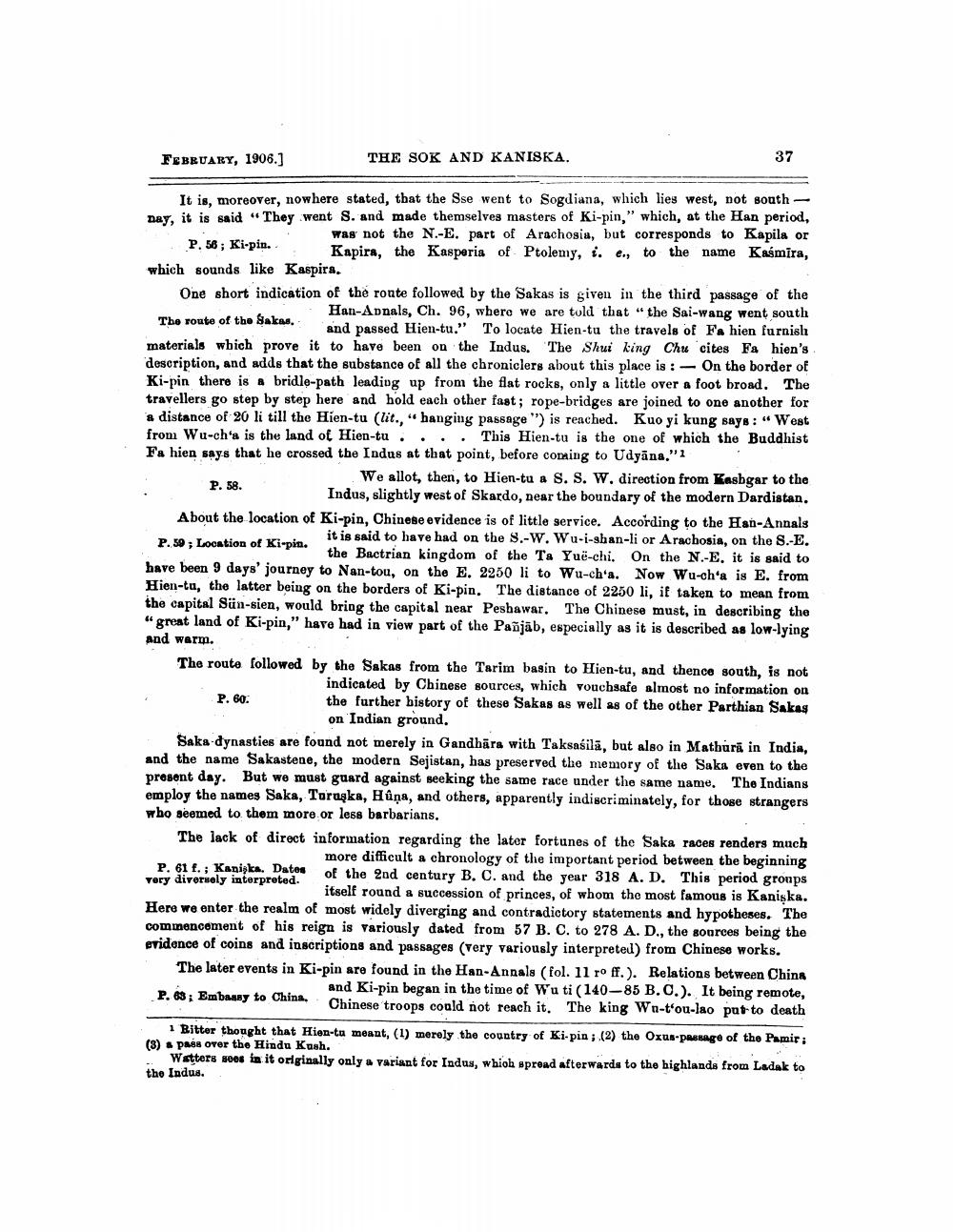________________
FEBRUARY, 1906.]
It is, moreover, nowhere stated, that the Sse went to Sogdiana, which lies west, not southnay, it is said "They went S. and made themselves masters of Ki-pin," which, at the Han period, was not the N.-E. part of Arachosia, but corresponds to Kapila or Kapira, the Kasperia of Ptolemy, . e., to the name Kaśmīra,
P. 56; Ki-pin. which sounds like Kaspira.
THE SOK AND KANISKA.
37
One short indication of the route followed by the Sakas is given in the third passage of the Han-Annals, Ch. 96, where we are told that "the Sai-wang went south The route of the Sakas.and passed Hien-tu." To locate Hien-tu the travels of Fa hien furnish materials which prove it to have been on the Indus. The Shui king Chu cites Fa hien's description, and adds that the substance of all the chroniclers about this place is: On the border of Ki-pin there is a bridle-path leading up from the flat rocks, only a little over a foot broad. The travellers go step by step here and hold each other fast; rope-bridges are joined to one another for a distance of 20 li till the Hien-tu (lit., " hanging passage ") is reached. Kuo yi kung says: "West from Wu-ch'a is the land of Hien-tu This Hien-tu is the one of which the Buddhist
Fa hien says that he crossed the Indus at that point, before coming to Udyana."1
We allot, then, to Hien-tu a S. S. W. direction from Kasbgar to the P. 58. Indus, slightly west of Skardo, near the boundary of the modern Dardistan. About the location of Ki-pin, Chinese evidence is of little service. According to the Han-Annals it is said to have had on the S.-W. Wu-i-shan-li or Arachosia, on the S.-E. P.59; Location of Ki-pin. the Bactrian kingdom of the Ta Yuë-chi. On the N.-E. it is said to have been 9 days' journey to Nan-tou, on the E. 2250 li to Wu-ch'a. Now Wu-ch'a is E. from Hien-tu, the latter being on the borders of Ki-pin. The distance of 2250 li, if taken to mean from the capital Sün-sien, would bring the capital near Peshawar. The Chinese must, in describing the "great land of Ki-pin," have had in view part of the Pañjab, especially as it is described as low-lying and warm.
P. 60.
The route followed by the Sakas from the Tarim basin to Hien-tu, and thence south, is not indicated by Chinese sources, which vouchsafe almost no information on the further history of these Sakas as well as of the other Parthian Sakas on Indian ground.
Saka-dynasties are found not merely in Gandhara with Taksaśila, but also in Mathura in India, and the name Sakastene, the modern Sejistan, has preserved the memory of the Saka even to the present day. But we must guard against seeking the same race under the same name. The Indians employ the names Saka, Turuşka, Húna, and others, apparently indiscriminately, for those strangers who seemed to them more or less barbarians.
P. 61 f.; Kaniska. Dates very diversely interpreted.
The lack of direct information regarding the later fortunes of the Saka races renders much more difficult a chronology of the important period between the beginning of the 2nd century B. C. and the year 318 A. D. This period groups itself round a succession of princes, of whom the most famous is Kaniska. Here we enter the realm of most widely diverging and contradictory statements and hypotheses. The commencement of his reign is variously dated from 57 B. C. to 278 A. D., the sources being the evidence of coins and inscriptions and passages (very variously interpreted) from Chinese works.
The later events in Ki-pin are found in the Han-Annals (fol. 11 ro ff.). Relations between China and Ki-pin began in the time of Wu ti (140-85 B. C.). It being remote, Chinese troops could not reach it. The king Wn-t'ou-lao put to death
P. 63; Embassy to China.
1 Bitter thought that Hien-tu meant, (1) merely the country of Ki-pin; (2) the Oxus-passage of the Pamir; (3) a pass over the Hindu Kush.
Watters sees in it originally only a variant for Indus, which spread afterwards to the highlands from Ladak to the Indus.




